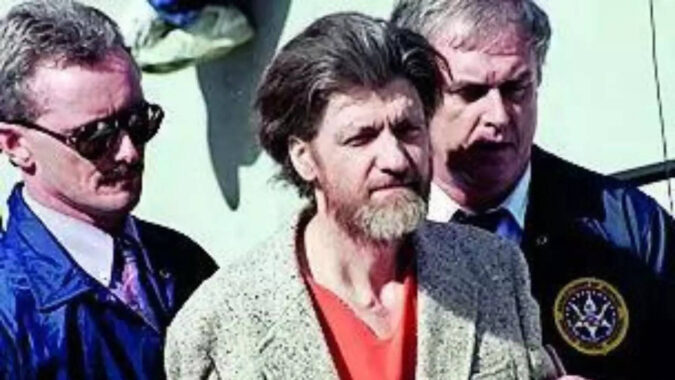WASHINGTON: Theodore “Ted” Kaczynski, the Harvard-educated mathematician who retreated to a dingy shack in the Montana wilderness and ran a 17-year bombing campaign that killed three people and injured 23 others, died Saturday. He was 81.
He attacked academics, businesspeople and random civilians with homemade bombs from 1978 to 1995, with the stated goal of bringing about the collapse of the modern social order — a violent spree that ended after what was often described as the longest and most costly search in American history.
Branded the “Unabomber” by the FBI, Kaczynski died at the federal prison medical center in Butner, North Carolina. He was found unresponsive in his cell early Saturday morning and was pronounced dead. A cause of death was not immediately known.
Before his transfer to the prison medical facility, he had been held in the federal Supermax prison in Florence, Colorado, since May 1998, when he was sentenced to four life sentences plus 30 years for acampaign of terror that set universities nationwide on edge. He admitted to 16 bombings that permanently maiming several of his victims.
Years before the Sept 11 attacks and the anthrax mailing, the Unabomber’s deadly homemade bombs changed the way Americans mailed packages and boarded airplanes, even virtually shutting down air travel on the West Coast in July 1995.
He forced The Washington Post , in conjunction with The New York Times, to make the agonizing decision in September 1995 to publish his 35,000-word manifesto, “Industrial Society and Its Future,” which claimed modern society and technology was leading to a sense of powerlessness and alienation.
But it led to his undoing. Kaczynski’s brother, David, and David’s wife, Linda Patrik, recognized the treatise’s tone and tipped off the FBI. Authorities in April 1996 found him in a 3-by-4-metre plywood cabin in Montana, that was filled with journals, a coded diary, explosive ingredients and two completed bombs.
In his own journals, Kaczynski came across not as a committed revolutionary but as a vengeful hermit driven by petty grievances. “I certainly don’t claim to be an altruist or to be acting for the ‘good’ (whatever that is) of the human race,” he wrote on April 6, 1971. “I act merely from a desire for revenge. ”
Kaczynski was certainly brilliant. He skipped two grades to attend Harvard at age 16 and had published papers in prestigious mathematics journals. His explosives were carefully tested and came in meticulously handcrafted wooden boxes sanded to remove possible fingerprints. Later bombs bore the signature “FC” for “Freedom Club. ”
The FBI called him the “Unabomber” because his early targets seemed to be universities and airlines
He attacked academics, businesspeople and random civilians with homemade bombs from 1978 to 1995, with the stated goal of bringing about the collapse of the modern social order — a violent spree that ended after what was often described as the longest and most costly search in American history.
Branded the “Unabomber” by the FBI, Kaczynski died at the federal prison medical center in Butner, North Carolina. He was found unresponsive in his cell early Saturday morning and was pronounced dead. A cause of death was not immediately known.
Before his transfer to the prison medical facility, he had been held in the federal Supermax prison in Florence, Colorado, since May 1998, when he was sentenced to four life sentences plus 30 years for acampaign of terror that set universities nationwide on edge. He admitted to 16 bombings that permanently maiming several of his victims.
Years before the Sept 11 attacks and the anthrax mailing, the Unabomber’s deadly homemade bombs changed the way Americans mailed packages and boarded airplanes, even virtually shutting down air travel on the West Coast in July 1995.
He forced The Washington Post , in conjunction with The New York Times, to make the agonizing decision in September 1995 to publish his 35,000-word manifesto, “Industrial Society and Its Future,” which claimed modern society and technology was leading to a sense of powerlessness and alienation.
But it led to his undoing. Kaczynski’s brother, David, and David’s wife, Linda Patrik, recognized the treatise’s tone and tipped off the FBI. Authorities in April 1996 found him in a 3-by-4-metre plywood cabin in Montana, that was filled with journals, a coded diary, explosive ingredients and two completed bombs.
In his own journals, Kaczynski came across not as a committed revolutionary but as a vengeful hermit driven by petty grievances. “I certainly don’t claim to be an altruist or to be acting for the ‘good’ (whatever that is) of the human race,” he wrote on April 6, 1971. “I act merely from a desire for revenge. ”
Kaczynski was certainly brilliant. He skipped two grades to attend Harvard at age 16 and had published papers in prestigious mathematics journals. His explosives were carefully tested and came in meticulously handcrafted wooden boxes sanded to remove possible fingerprints. Later bombs bore the signature “FC” for “Freedom Club. ”
The FBI called him the “Unabomber” because his early targets seemed to be universities and airlines
